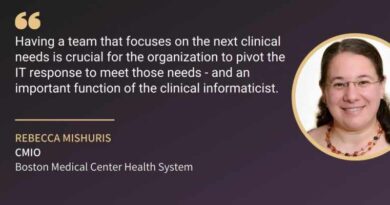The evolving role of physician leadership in healthcare digital transformation: choosing the right technology partners for Population Health Management
By Vincenzo Scivittaro, MD, MS-MIS, Director, Health Informatics and Population Health Solutions, IBM Watson Health
The healthcare industry is going through an incredibly massive digital transformation, and this change comes with new responsibilities for the clinical leaders of healthcare organizations. Traditionally, is the Chief Medical Information Officer (CMIO) that is tasked with the role of Information Technology (IT) physician executive. Depending from organization structure and dimension, that role may be taken, or shared, by the Chief Medical Officer (CMO), or by the VP of Quality, or by others. Regardless, physician leadership in health care information technology acquisition and management is a crucial requirement for the success of healthcare digital transformation.
IT physician executives need to act as “transformational leaders” in strategizing a health care system’s successful transition to digital Population Health Management.
The changing environment
There is a sea change occurring in American healthcare. Aging population and a steady rise in the incidence of chronic diseases have created unsustainable cost pressures on health systems. The development of outcome- and value-based health care delivery models and the associated reimbursement constructs, including ACOs, value-based purchasing, clinically integrated networks, and bundled payments, have generated an environment in which hospitals and physicians are scrambling for a diminishing piece of the reimbursement pie. At the same time, especially in Population Health Management (PHM), the focus is turning to the individual. Access to unprecedented amounts of data creates an opportunity for deeper insight, earlier intervention, and a new level of engagement. The rising voice of the consumer is empowering individuals to expect higher quality at lower cost.
This shift toward value and consumerization is accompanied by the availability of innovative technologies as never seen in the past. New technologies are driving exponential change and opportunity into an industry traditionally slow to adapt and alarmingly vulnerable to attacks and disruption, and, in turn, new players are entering and reshaping the industry.
The CMIO agenda for the Population Health Management Digital Ecosystem
Healthcare organizations are focusing on what technology can do across the continuum and outside their walls, in order to positively affect population health. In the progressively more common clinically integrated organizations, the IT physician executive must be able to interact with other executive leaders, as well as possibly multiple regional CMIOs, and strategically direct the integration of ambulatory care, in-patient care, and post-acute care, both inside and across organizations.
In this environment, physician executives must expect from technology partners greater value, improved quality, and better outcomes – at a more affordable cost. A slew of new technologies is disrupting the PHM ecosystem, and each has the potential to dramatically improve the translation of disparate data and analytic models to value for the patient.
As the amount and types of healthcare data grow, it is becoming increasingly complex to manage and, ironically, more complex to use for insight generation. The hybrid cloud is a cloud computing environment that uses a mix of on-premises, private, clouds and third-party public cloud services. This “multicloud” capability is a key characteristic to emphasize because it enables the ecosystem to move beyond the constraints of legacy and provides the flexibility to expand across partner organizations and payer-provider networks. The hybrid cloud enables the storage and management of multiple healthcare data types on a robust IT platform with native security and privacy features, high availability, low operational overhead, and global connectivity. Healthcare organization of all sizes can take advantage of the latest technologies, such as integrated analytics and machine learning, to obtain advanced data insights, without the need for individual organizations to build them by themselves.
APIs and Microservices enable trusted connections with advanced cloud capabilities. They are essential for the development, rapid prototyping, and deployment of convenient, easy-to-use applications. APIs bridge the gap between care system and advanced capabilities built on the Cloud.
Finally, Artificial Intelligence (AI) and advanced analytics bring the most potential to redefine the use of data to fundamentally impact PHM outcomes. Increasing analytics maturity is going to raise the bar for data-driven insights, from descriptive to predictive to prescriptive. And while advanced analytics respond to specific coded requests to make determinations, AI systems will interact with humans naturally to interpret data, will learn from every interaction, and will propose new possibilities through probabilistic reasoning.
Choosing your technology partners
IT Physician executives need to embrace the newest technologies to advance the PHM mission and drive value. In doing so, they need to demand from their technology partners an unapologetic focus on experience with a continuous drive to improve, reinvent and impact behavior. More than any other executive in the healthcare organization, the CMIO must clearly articulate to potential partners the contributions you seek to the outcomes that matter.
Proposed technological solution must protect your data and create “evidence platforms” to fuel clinical decision support and real-time analytics. Any PHM solution needs to place the whole person into the heart of the digital healthcare ecosystem, and extend empowerment using mobile and the Internet of Things.
PHM AI solutions need to accelerate pattern identification across populations and fine-tune delivery of care up to personalized patient engagement; in other words, move from reactive to proactive PHM.
Each new technology solution must also be flexible enough to share data, partner and platform for scale, and access multicloud solutions. Any solution must be available to build ecosystems with new or unlikely partners, to advance real interoperability across the continuum of care and payer-provider networks.
Finally, it is the physician executive that must identify and understand the technology partner basis of differentiation for quality and efficiency and expect them to invest in your success. The most trustworthy and confident partners will support your digital transformation by sharing risks and rewards.
In conclusion, IT physician executives need to act as “transformational leaders” in strategizing a health care system’s successful transition to digital Population Health Management and demand from their technology partners innovative and effective solutions that support digital transformation while sharing risks and rewards. Regardless of title or role, physician leadership in health care technology will only continue to grow in importance, including increased responsibility for operational management of a digitally advanced population health ecosystem.



